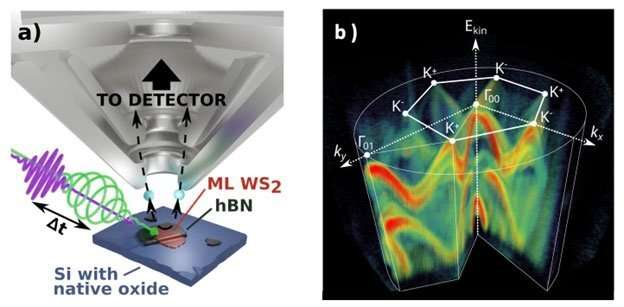This article has been reviewed according to Science X's editorial process and policies. Editors have highlighted the following attributes while ensuring the content's credibility:
fact-checked
peer-reviewed publication
trusted source
proofread
Directly imaging quantum states in two-dimensional materials

When some semiconductors absorb light, excitons (or particle pairs made of an electron bound to an electron hole) can form. Two-dimensional crystals of tungsten disulfide (WS2) have unique exciton states that are not found in other materials. However, these states are short lived and can change from one to another very quickly.
Scientists have developed a new approach to create separate images of these individual quantum states. By tracking the individual quantum states, researchers showed that the coupling mechanisms that lead to mixing of the states may not fully match current theories.
Scientists are excited about transition metal dichalcogenides, the family of crystals that includes tungsten disulfide, because they absorb light very strongly despite being only a few atoms thick. Researchers could use these crystals to build new nanoscale solar cells or electronic sensors. Using a new technique called time-resolved momentum microscopy, researchers can now better track the transitions between different exciton quantum states. This technique is broadly applicable, so scientists can now put other next-generation materials and devices under this momentum microscope to see how they work.
A variety of light-induced exciton states can form in monolayer transition metal dichalcogenides (TMDs) like WS2 under different conditions. Varying the wavelength or power of the exciting light or the temperature of the crystal allows different exciton states to form or persist. Light that is circularly polarized, where the direction of the electric field rotates around the direction the light wave travels, can selectively create excitons with a given quantum spin configuration in a specific set of energy bands.
Researchers at Stony Brook University have developed a unique instrument to directly visualize this effect under different ultrafast light excitation conditions and disentangle the complex mixture of quantum states that can form.
Published in Physical Review Letters, these new findings show how the force that binds the electron and electron hole together in the exciton also contributes to very rapid coupling, or mixing, of different exciton states. The researchers demonstrated that this effect leads to mixing of excitons with different spin configurations while still conserving both energy and momentum in the coupling process.
Surprisingly, the results showed that the rate of exciton mixing did not depend on the exciton energies as researchers had previously predicted. This study provides crucial experimental support for some current theories of exciton coupling in TMDs, but also sheds light on important discrepancies. Understanding the interplay between these exciton states is a key step towards the harnessing potential of TMDs for nanotechnology and quantum sensing.
More information: Alice Kunin et al, Momentum-Resolved Exciton Coupling and Valley Polarization Dynamics in Monolayer WS2, Physical Review Letters (2023). DOI: 10.1103/PhysRevLett.130.046202
Journal information: Physical Review Letters
Provided by US Department of Energy



















